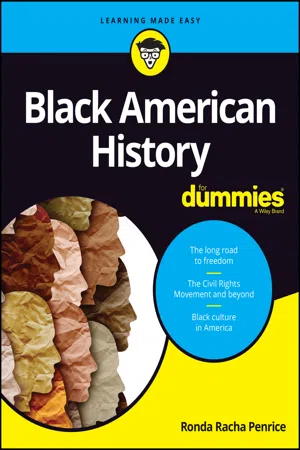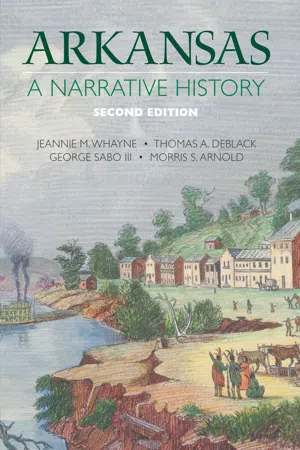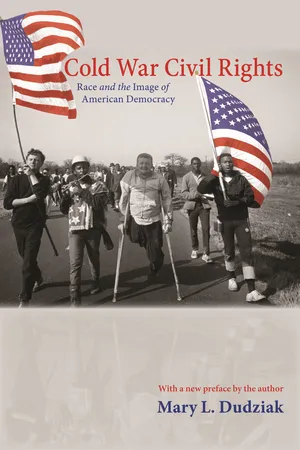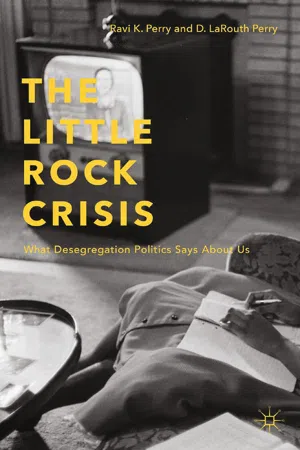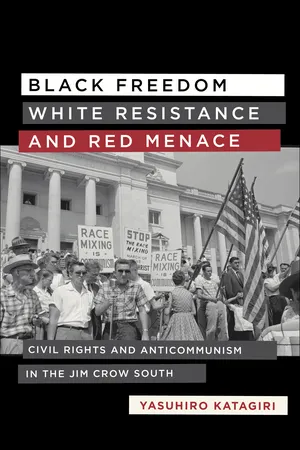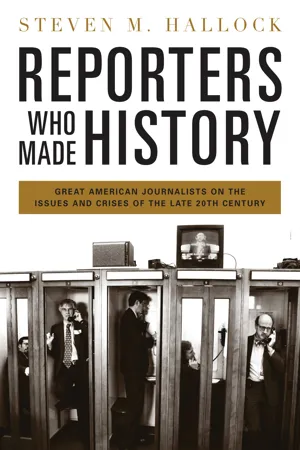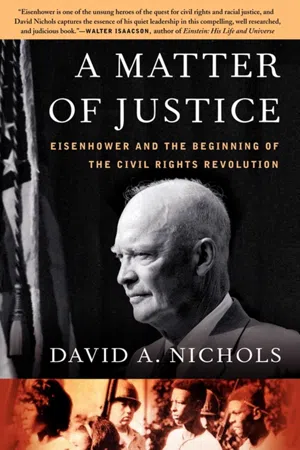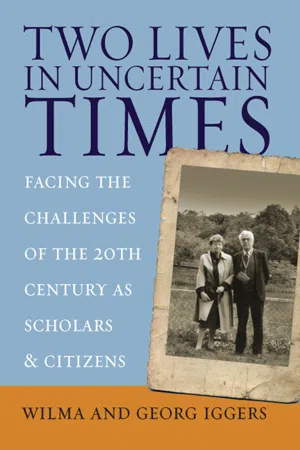History
Little Rock Nine
The Little Rock Nine refers to a group of African American students who were the first to integrate Little Rock Central High School in Arkansas in 1957. Their enrollment was met with violent opposition, leading to a significant moment in the civil rights movement. The event highlighted the struggle for desegregation and the bravery of those who fought for equal rights.
Written by Perlego with AI-assistance
Related key terms
1 of 5
12 Key excerpts on "Little Rock Nine"
- eBook - ePub
- Ronda Racha Penrice(Author)
- 2021(Publication Date)
- For Dummies(Publisher)
A mob of roughly 300 gathered by morning. When the nine Black students, called the Little Rock Nine, tried to enroll in Central High the next day, members of the Arkansas National Guard turned them away. Frantic, the school board requested a stay of the integration order on September 7, but Judge Davies rejected the request. On September 10, Governor Faubus received a federal summons; he also held a press conference and announced that the armed presence outside the school would remain. Wisely, the Little Rock Nine didn’t attempt to enroll again before the hearings. On September 20, Faubus, following a court order, removed the troops. Eisenhower steps in and the students enroll On September 23, the Little Rock Nine made another attempt to enroll in Central High, but uncontrolled violence erupted and they left school before the day ended, spurring President Dwight D. Eisenhower to intervene. Although far from a drum major for integration, Eisenhower wouldn’t permit blatant disregard for the laws of the land. On September 24, President Eisenhower addressed the American public on national television to explain his decision to intervene. He said, “The very basis of our individual rights and freedoms rests upon the certainty that the president and the executive branch of government will support and insure the carrying out of the decisions of the federal courts.” He insisted, “The interest of the nation in the proper fulfillment of the law’s requirements cannot yield to opposition and demonstrations by some few persons. Mob rule cannot be allowed to override the decisions of our courts.” Protected by federal troops, the Little Rock Nine enrolled in Central High on September 25, 1957, but they continued to be victimized. White students verbally and physically abused them, and segregationists harassed their families and members of the Black community in general. Bowing to the pressure, Minnijean Brown poured a bowl of chili over a white student’s head and was expelled - eBook - ePub
Arkansas
A Narrative History
- Jeannie M. Whayne, Thomas A. DeBlack, George Sabo, Morris S. Arnold, George Sabo, III(Authors)
- 2014(Publication Date)
- University of Arkansas Press(Publisher)
Aaron v. Cooper (Aaron the name of the first child listed on the suit; Cooper being William G. Cooper, president of the Little Rock School Board). Their efforts and their suit were undermined by the actions of Little Rock’s white school superintendent Virgil Blossom and the Little Rock School Board, which presented an integration plan that was far different from what the black activists promoted. It provided for only modest integration of Central High School, a school in a working-class neighborhood. Yet Daisy Bates and a small group of African American activists decided to work with Blossom, and they carefully selected nine students—who became known as the “Little Rock Nine”—to make the move into Central High School in the fall of 1957: Minnijean Brown, Elizabeth Eckford, Ernest Green, Thelma Mothershed, Melba Pattillo, Gloria Ray, Terrance Roberts, Jefferson Thomas, and Carlotta Walls.”Aaron v. Cooper: A suit filed by the parents of thirty-three black students in Little Rock after the Supreme Court issued its “all deliberate speed” decision in 1955, a follow-up to the Brown decision in 1954.Little Rock Nine: The nine black students who integrated Central High School in Little Rock in 1957.Even as Bates was preparing the children for entry into Central High, Faubus took another step away from racial progressivism and mortgaged his political future to the extreme segregationists in order to secure approval of an ambitious twenty-two-million-dollar legislative package. To gain the support of east Arkansas planters for a package that included increases in benefits to the elderly and higher teacher salaries, Faubus acquiesced to four bills designed to delay desegregation, something that was not so very far from measures he hinted might be necessary in his first run for the governor’s office in the race against Cherry. These measures, if Faubus had attempted to enforce them, would have provided financial aid to schools attempting to resist integration, changed school attendance laws in a manner designed to make sure that certain whites did not have to attend school with blacks, required the NAACP to publish its membership lists, and established a state sovereignty commission with the express purpose of studying how to effectively block federal integration efforts. When Faubus failed to enforce the four measures, pressure from the extreme segregationists mounted. - eBook - ePub
Cold War Civil Rights
Race and the Image of American Democracy
- Mary L. Dudziak(Author)
- 2011(Publication Date)
- Princeton University Press(Publisher)
CHAPTER 4
Holding the Line in Little Rock
Little Rock has unfortunately become a symbol of Negro-White relations in the United States.AMERICAN CONSULATE, LOURENÇO MARQUESZ, MOZAMBIQUETO DEPARTMENT OF STATE, SEPTEMBER 30, 19571The school year would not begin easily in Little Rock, Arkansas, in 1957. On September 4 of that year, nine African American students tried to enroll at Little Rock’s Central High School. Their admission had been ordered by a federal district court. However, just two days earlier, Arkansas Governor Orval Faubus declared that the students’ enrollment threatened “imminent danger of tumult, riot and breach of the peace and the doing of violence to persons and property.” He proclaimed a state of emergency and ordered the Arkansas National Guard into service. These troops surrounded Central High School on September 4 and turned the students away as they tried to enter the school.2What transpired that day would capture the attention of the international media and of President Dwight D. Eisenhower. School desegregation in Little Rock was no longer a local or state issue, but a critical national problem.3As the Arkansas Gazette reported it,The first Negro applicant to try to enroll at Little Rock Central High School . . . , Elizabeth Eckford, 15, was twice blocked from entering the grounds, walked calmly down two blocks then sat out 35 minutes of vocal abuse while waiting for a bus to go home. . . . When she approached Guardsmen at the corner they drew together and blocked her entrance to the sidewalk.4Eckford was harassed in front of television cameras as “a crowd of 200 saw her and rushed to the scene.” A white woman, Grace Lorch, ultimately came to her defense and boarded a bus with Eckford, taking her away from the scene. Seven of the nine students arrived together and, on orders of the governor, were also turned away.5Governor Faubus was something of a latecomer to resistance. Little Rock had a reputation as a progressive southern community, and Faubus had been thought of as a moderate. In contrast to Georgia Governor Herman Talmadge, Faubus had given no speeches of defiance after Brown was decided. Instead, he gave African Americans a role in the state Democratic leadership during the 1954 gubernatorial campaign. In addition, there was progress, albeit with mixed success, toward desegregation in other communities in Arkansas after 1954. Faubus’s most direct statements on school desegregation prior to Little Rock were to declare the issue a local one, to be handled by local school boards.6 - eBook - ePub
The Long Shadow of Little Rock
A Memoir
- Daisy Bates, Eleanor Roosevelt, Clayborne Carson(Authors)
- 2007(Publication Date)
- University of Arkansas Press(Publisher)
CHAPTER XI
THE EMBATTLED NINE
THE first few days at Central High School didn't add up to the most pleasant experience ever enjoyed by the nine Negro pupils, but neither was it the worst. In fact there were encouraging signs that the “Battle of Little Rock” was about to fade into history and that the process of integration might henceforth proceed without incident.Minnijean was invited to join the school glee club, others were invited to lunch with their white fellow-students. A few days before the embattled nine entered the high school, the student newspaper, the Tiger, carried the following article, written by Jane Emery, co-editor of the paper:You are being watched! Today the world is watching you, the students of Central High. They want to know what your reactions, behavior, and impulses will be concerning a matter now before us. After all, as we see it, it settles down now to a matter of interpretation of law and order.Will you be stubborn, obstinate, or refuse to listen to both sides of the question? Will your knowledge of science help you determine your action or will you let customs, superstition, or tradition determine the decision for you?This is the chance that the youth of America has been waiting for. Through an open mind, broad outlook, wise thinking, and a careful choice you can prove that America's youth has not ‘gone to the dogs,’ that their moral, spiritual, and educational standards are not being lowered. This is the opportunity for you as citizens of Arkansas and students of Little Rock Central High to show the world that Arkansas is a progressive, thriving state of wide-awake alert people. It is a state which is rapidly growing and improving its social, health, and educational facilities. That it is a state with friendly, happy, and conscientious citizens who love and cherish their freedom.It has been said that life is just a chain of problems. If this is true, then this experience in making up your own mind and determining right from wrong will be of great value to you in life. - eBook - ePub
- Erin Krutko Devlin(Author)
- 2018(Publication Date)
- University of Massachusetts Press(Publisher)
5 In this spirit, the Little Rock Nine have challenged the way the Little Rock school desegregation crisis has been framed through memoirs, films, and countless speaking engagements. In doing so, they have resisted the processes of historical erasure that support “Won Cause” mythology and have worked toward preserving a “memory for the future” designed to build and sustain a more equitable society.FIGURE 11. The Little Rock Nine have engaged directly with the public memory of the 1957 school desegregation crisis, challenging Arkansas and the nation to confront its history. The power of their personal testimony is symbolically evoked in the Testament monument, in which bronze statues representing the Little Rock Nine stand on the lawn of the Arkansas State Capitol, visible from the same governor’s office once occupied by Orval Faubus. (Raymond K. Cunningham, Jr.)The contest over the public memory of the school desegregation crisis has deeper implications and broader social effects. The reification of the triumphal narrative of progress into Supreme Court jurisprudence at the turn of the twenty-first century demonstrates that our public histories matter. The logic undergirding the Court’s recent school desegregation decisions has been rooted in an effort to define racial discrimination as narrowly as possible, minimizing its effects in the past and its persistence in the present. In this context, contemporary racial inequality has not been attributed to systemic racism or institutionalized white privilege, but rather to “natural” preferences or cultural deficiencies within black communities. Moreover, the triumphal narrative of progress has enabled a “rearticulation” of the functional meaning - eBook - ePub
Public Opinion in the United States
Studies of Race, Religion, Gender, and Issues That Matter
- Rita J. Simon(Author)
- 2017(Publication Date)
- Taylor & Francis(Publisher)
Board of Education, the National Association for the Advancement of Colored People (NAACP) registered nine black students, later known as the Little Rock Nine, to attend the previously all-white Little Rock Central High School. But segregationists threatened mass protests, and the State Governor deployed the Arkansas National Guard on September 9, 1957, to block the nine black students from reaching their school. The incident attracted national attention, and raised the polarizations between the two groups supporting and opposing racial integration. President Eisenhower intervened and summoned the Arkansas governor to meet him.Attorneys from the U.S. Justice Department requested an injunction against the governor, which was granted, and the District Court for the Eastern District of Arkansas ordered the governor to withdraw the National Guard on September 20. The police then slipped the students into their schools, and confronted the protesting parents of white students. On September 24, President Eisenhower ordered the deployment of army troops in Little Rock, and federalized the Arkansas National Guard to ensure the safety of the Little Rock Nine and enforce integration.Another event that helped spread the Civil Rights cause was the so-called Greensboro sit-ins in 1960. Sit-ins were an established technique for the Civil Rights Movement given its overall nonviolent approach to social change. However, these sit-ins were the most influential because of the media attention they attracted and their broad scope. The events leading to the protest started in February 1960, when four students from North Carolina Agricultural and Technical State University (NC A&T), a historically segregated school, were denied the right to sit down in the Woolworth lunch counter. They were told that because of their race they had to stand up at another counter to eat. The young men stood and stayed until the store closed, and students returned to sit-in the next day. This protest continued for six months, joined by other similar protests in different cities and states. While many local stores changed their policies regarding racial segregation, the main legal change had to await the passage of the landmark Civil Rights Act of 1964, which was followed by the Voting Rights Act of 1965.1 - eBook - PDF
We Ain’t What We Ought To Be
The Black Freedom Struggle from Emancipation to Obama
- Stephen Tuck(Author)
- 2011(Publication Date)
- Belknap Press(Publisher)
The next day, the president ordered in the paratroopers. Facing a mob in Little Rock was child’s play compared with facing an armed enemy in the Korean jungle, and the troops quickly ensured the students’ entry into the school. Thus, Little Rock became a pincer movement against segrega-tionists—an assault by black southern protesters on one side and by the federal government on the other. As with many transfer students across the South, the first year was full of insults for the Little Rock Nine. Bates encouraged them not to retaliate but to complain to school staff. The feistiest student, Minnejean Brown, eventually snapped. At lunchtime one day she tipped a bowl of chili over two of her tormentors and soon afterward was expelled. (The girls’ vice-principal wrote admiringly in her diary, “I can’t help liking her natural reaction . . . This bowl of chili no doubt has been heard around the world!”) 95 Some children started a chant, “One nigger down and eight to go.” But the other eight made it. Ernest Green was the first to get his di-ploma. Martin Luther King Jr. joined Bates at the graduation. The Limits of Protest Because the southern Civil Rights Movement would follow in the early 1960s, it might be tempting to see the high-profile confrontations of the 1950s as stepping-stones toward triumph. But Montgomery and Trumbull Park, Little Rock and Levittown, showed that progress seemed anything but inevitable at the time. White violence in the North surprised the first pioneer families in white neighborhoods. Violence in the South did not surprise anyone, but it continued to shock nonetheless. Between T H R E E S T E P S F O R W A R D , T W O S T E P S B A C K , 1 9 4 9 – 1 9 5 9 2 7 1 the Brown decision and the closing of Little Rock’s high schools, there were 225 recorded instances of attacks on civil rights activists, private homes, and institutions. 96 There was certainly no sense of steady gains during the decade. - eBook - ePub
The Little Rock Crisis
What Desegregation Politics Says About Us
- R. Perry(Author)
- 2015(Publication Date)
- Palgrave Macmillan(Publisher)
That Act also gave additional powers to the office of the US Attorney General, who could now seek court injunctions against deprivation and obstruction of voting rights by state officials. 15 Cultural histories collided in Little Rock in 1957 without regard to national or neighboring histories. It must be that Little Rock was destined to make its unique, permanent, and, eventually, regrettable mark on history by denying nine African American students entrance into the all-white Central High School. * * * A theme of this book is to examine how acquired cultural habits determine present behavior and how exposure to the crisis has impacted people’s political behavior. The desegregation crisis dramatized for the world how problematic it is for conflicting belief systems to coexist. The probe into what happens when cultural histories meet will perhaps explain why the memory of the crisis won’t fade for many, and why the learning of the crisis has changed the lives of many who weren’t even alive when it occurred. This book offers several contributions. We have taken on the task of telling, while analyzing some of the first key texts on the crisis, the story of Little Rock’s desegregation crisis and how that story has lived itself over time, in the lives of many. The invaluable sources we’ve used focus on the crisis through the lens of the moment—a single component of the crisis; for example, Crisis at Central High concentrates on the 1957–1958 school year events within the school. 16 The Long Shadow of Little Rock reveals Daisy Bates’s involvement with the community, the school board, and the Little Rock Nine during the same year. 17 Books by Superintendent Blossom, Dale Alford, Sara Murphy, Terrence Roberts, Carlotta Walls LaNier, and Melba Pattillo Beals present details of their participation - eBook - ePub
Black Freedom, White Resistance, and Red Menace
Civil Rights and Anticommunism in the Jim Crow South
- Yasuhiro Katagiri(Author)
- 2014(Publication Date)
- LSU Press(Publisher)
CHAPTER 4
“A PEACEFUL PEOPLE HAVE BEEN TORN ASUNDER BY THE COMMUNIST CONSPIRACY”The Little Rock Desegregation Crisis in Arkansas as aTurning Point in Massive Resistance
In several respects, the 1957 Little Rock, Arkansas, desegregation crisis was one of the defining moments in America’s civil rights movement. With the values of American democracy at stake in a Cold War environment, federal troops, for the first time since Reconstruction, used their might to protect black civil rights in the South, demonstrating the federal government’s resolve to bolster the “American way of life” in the face of southern defiance. Not only was the Little Rock crisis the first dramatic confrontation between a southern state and the federal government over school desegregation, but it also represented a pivotal turning point in white southerners’ resistance movement to the civil rights crusade. After the Little Rock incident, the architects and practitioners of the South’s massive resistance realized that their strategy of employing the revived theory of states’ rights constitutionalism—or the doctrine of interposition—could no longer be counted upon to preserve the region’s racial segregation.One of the central figures in the Little Rock desegregation ordeal, who eventually ended up siding with the proponents of massive resistance, was Arkansas governor Orval E. Faubus. Elected as governor of the Peripheral South state six months after the Supreme Court announced its May 1954 Brown decision, Faubus had never been a fanatic segregationist prior to the showdown at Central High School, where the capital city’s token desegregation process, devised by the Little Rock School Board, was to start in the fall of 1957 “with all deliberate speed.” In fact, Faubus, the son of a known Socialist, John Samuel “Sam” Faubus, and a racial moderate in the South’s contemporary standard, was an unlikely villain in the drama that unfolded over the desegregation of the city’s all-white Central High School.1 By the same token, the city of Little Rock was also an unlikely place for an all-out state-federal confrontation over public school desegregation. Though it may not have been a genuinely progressive southern city, Little Rock nevertheless showed a much greater degree of racial tolerance than did many cities in the Deep South states. Little Rock’s relative racial moderation, for instance, was evidenced in April 1956 in its voluntary abolition of segregated seating on the city’s public bus transportation system.2 - eBook - PDF
Reporters Who Made History
Great American Journalists on the Issues and Crises of the Late 20th Century
- Steven M. Hallock(Author)
- 2009(Publication Date)
- Praeger(Publisher)
And by preaching the protests in their churches and mass meetings they gave it the dynamism of a religious crusade, bringing to bear the strongest emotional force in the Negro community. 27 Still, the battle waged by white supremacists against the basic rights of black citizens persisted. One of the uglier episodes of the 1950s occurred in Little Rock, Arkansas, a community that Lewis described in his book as The ’50s of Anthony Lewis and Helen Thomas 51 a “city of the New South, a middle class, moderate town with an enlight- ened mayor ( Woodrow Wilson Mann), congressman ( Brooks Hays) and newspaper (the Arkansas Gazette, edited by Harry Ashmore).” The state, Lewis wrote, already had integrated education at the university level, “and Governor Orval Faubus had never been a race-baiter; indeed, his election had been considered a liberal victory. The federal courts had approved a desegregation plan, it was to begin with the senior high schools in the fall of 1957 — specifically, with the admission of a few Negro children to Cen- tral High School on Tuesday, September 3, 1957.” 28 Nonetheless, the night before school began, the governor announced on television that carrying out the ordered integration would be impossible the next day and said he was ordering National Guardsmen to the school to act “not as segregationists or integrationists but as soldiers.” “ The Guardsmen,” Lewis wrote, “acted as soldiers on the side of segre- gation. They were there the next morning, two hundred and seventy of them, and on the advice of the School Board no Negro child appeared.” And when nine black students tried to attend the following morning, a waiting crowd greeted them, and a National Guardsman barred the door. - eBook - ePub
A Matter of Justice
Eisenhower and the Beginning of the Civil Rights Revolution
- David A. Nichols(Author)
- 2007(Publication Date)
- Simon & Schuster(Publisher)
CHAPTER EIGHTThe Little Rock Crisis
The Federal Constitution will be upheld by me by every legal means at my command. —DWIGHT D. EISENHOWER, SEPTEMBER 5, 1957O n Monday, September 2, 1957, in a 10:30 P.M. radio speech, Democratic Governor Orval Faubus of Arkansas announced that he had ordered units of his state’s National Guard to surround Central High School in Little Rock, preparatory to classes beginning the morning of September 3. Faubus claimed that he was sending the troops to prevent violence, but his real purpose was to prevent nine African-American children from entering the school in fulfillment of a federal court desegregation order.1This news was not welcome at the White House. Eisenhower was weary from the struggle to pass the civil rights act. The president needed a vacation, as did Mrs. Eisenhower, who was recovering from surgery, and they were scheduled to depart on Wednesday, September 4, “for a rest” at the Newport, Rhode Island, naval base. “Rest” to Eisenhower meant golf. He liked the course at the Newport Country Club and looked forward, according to Sherman Adams, “to entertaining a few friends whom he could beat when his game was right.”2 Thanks to Governor Faubus, Ike’s stay in Newport would not be much of a vacation.A Defiant GovernorA crisis in Little Rock had been simmering for some time. The city’s school board had adopted a plan on May 24, 1955, for gradual integration of the schools. The plan had called for implementation in fall 1957 and then only in the city’s high schools. Negro students were not eligible to enroll in the city’s high schools until 1957 but, in January 1956, twenty-seven African-American students attempted to register ahead of schedule and were turned away. On February 8 of that year, the NAACP filed suit on behalf of those students but Arkansas’ western district federal judge, John E. Miller, dismissed the suit. The Arkansas legislature passed bills on February 19, 1957, that abolished mandatory attendance at integrated schools and authorized funds for the state to use to fight integration. Governor Faubus, armed with these laws, tried to convince the Little Rock school board to rescind its integration plan, but the board refused. On April 27, 1957, the Eighth Circuit Court of Appeals upheld Judge Miller’s ruling against the NAACP’s suit and approved the school board’s original plan to implement limited integration in September 1957.3 - eBook - ePub
Two Lives in Uncertain Times
Facing the Challenges of the 20th Century as Scholars and Citizens
- Wilma Iggers, Georg Iggers(Authors)
- 2006(Publication Date)
- Berghahn Books(Publisher)
We felt very much at home in Fayetteville. We enjoyed the liberal atmosphere and soon found friends in various departments. One unpleasant problem arose at the beginning. The chair of the history department, Clifton Westermeyer, refused to let me have an office in the department. The reason he gave was that he had not been consulted by Dean Nichols, but it was apparent that he did not approve of my politics. Fortunately, he left fairly soon and my relations with the other members of the department were generally congenial. The small philosophy department was very glad to have me and to give me office space.During the year in Fayetteville I kept in close contact with the Little Rock branch of the NAACP. The federal courts finally ruled in our case, not quite as we had hoped, with a broad ruling mandating the desegregation of the Little Rock schools, but in a much more limited way, ordering the admission of nine black students to Little Rock Central High School at the beginning of the school year in September 1957. Although the White Citizens Councils threatened violence and the Attorney General of Georgia traveled to Little Rock to urge noncompliance, we expected everything to go smoothly. I flew to Little Rock once more two weeks before the opening of school for a planning meeting. We drove to Little Rock over the Labor Day weekend to say goodbye to friends on our way to New Orleans, where we had accepted positions at Dillard University. No one expected trouble. The headline of the Arkansas Gazette on Labor Day was “Little Rock Quiet on Eve of Opening of Integrated Schools.” Our last stop was at the Bates’. Their house was barricaded. Bullets had been shot through windows and we met in their basement with our children, who did not understand why we could not meet upstairs. That evening, Labor Day, the day before the schools were to open in Little Rock on Tuesday, September 3, we arrived in New Orleans. We were totally surprised and shocked when we heard on the radio the next morning that Governor Faubus had called out the National Guard to bar the nine students from entering the school.What happened hit us very deeply. Eight of the students had arrived at the school together; they were unable to reach the ninth student, Elizabeth Eckford, who had no telephone and went by herself. When she arrived outside the school she was surrounded by a threatening mob. Grace Lorch, Lee ’s wife, who had come to observe, went into the crowd to rescue Elizabeth Eckford, and took her to the nearest bus stop, where she was now surrounded by a host of reporters. Grace then brought Elizabeth home. The next day the story appeared in newspapers throughout the country. Not long afterward Grace was subpoenaed to appear before Senator James Eastland’s Internal Security Subcommittee of the Senate Judiciary Committee in nearby Memphis, without being given time to obtain counsel. The subpoena was clearly intended to smear her in the press as a Communist. Now the home of the Lorches became the target of acts of violence. Their daughter Alice, then fourteen years old, was repeatedly insulted and threatened. They nevertheless remained in Little Rock until the end of the academic year and then went to Wesleyan University where Lee had a one-year visiting appointment. At the end of that year, with Lee blacklisted in the United States, they emigrated to Canada, first to the University of Alberta in Edmonton and then to York University in Toronto. Lee had a distinguished career in Canada and became a fellow of the prestigious Royal Canadian Academy of Science.
Index pages curate the most relevant extracts from our library of academic textbooks. They’ve been created using an in-house natural language model (NLM), each adding context and meaning to key research topics.
